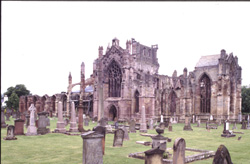 |
 |
 |
 |
 |
 |
 |
|
|
Waldef (Waltheof), abbot of Melrose Waldef’s face was the faithful interpreter
of the inner man and gave Waldef (Waltheof) was the son of Earl Simon of Northampton and Matilda, the great niece of William the Conqueror.(2) He was probably named after his grandfather, Waldef, earl of Northumbria, who was accused in 1076 of conspiring against William I (1066-87) and executed for treason. Matilda later married Earl David of Huntingdon, the future king of the Scots (1124-53), which meant that Waldef was later raised at the royal court of Scotland. It was here that he met Aelred, later abbot of Rievaulx. As a boy, Waldef showed signs that he was destined for the religious life: whereas his brother ‘mounted his hobby-horse like a charger, seized a stick and brandished it like a lance, and played soldier with the rest of the boys, pretending to be the castellan of imaginary castles’, the young Waldef built toy churches from wicker or stones ‘and with hands stretched out would pretend that he was the priest saying Mass.’ (3) Waldef later entered the Augustinian priory at Nostell, near Pontefract, where he held the office of sacrist. He later became prior of Walter Espec’s Augustinian foundation, Kirkham Priory. It was during this period that Waldef, was allegedly so impressed by the Cistercian way of life that he decided to convert and join the White Monks. Waldef entered Warden, a daughter-house of Rievaulx, but spent some time at Rievaulx c. 1143-8, probably in 1147. This was by no means an easy transition and Waldef faced moments of great doubt: It seemed to him that the food and drink were tasteless,
the clothing
Fortunately God responded to Waldef’s cry for help and freed him from this ‘temptation’. Thereafter he found the burden light and completed his probationary period. In 1148 Waldef was sent to lead David of Scotland’s foundation at Melrose, a daughter-house of Rievaulx. He presided as abbot until the 3 August 1159, when ‘the divine clemency sent an angel to snatch him from prison.’ (5) Waldef was at first buried at the entrance to the chapter-house at Melrose, ‘the womb of the Mother of all’, (6) a spot which he himself had selected, but his remains were later translated to the church.Following his death Waldef was celebrated as a saint, although he was never formally canonised. On two occasions his tomb was opened before witnesses who testified to the incorruption of his body, first in 1170 and again in 1206. However, by 1240, when all the remains of abbots buried in the chapter-house were relocated to a different area of the building, Waldef’s bones had turned to dust; a few small bones and teeth that remained were kept as relics. Waldef’s life was written c. 1210 by Jocelin of Furness, who was commissioned by Abbot Patrick of Melrose (1206-7).(7)
|
